Selection of cable structure should be based on the function and shape of the building, comprehensively consider the supply of materials, processing, production, and on-site construction and installation methods, choose a reasonable structural form, edge components, and supporting structure, and should ensure the overall rigidity and stability of the structure.
When the cable structure is used for the roof of the building, it is appropriate to use the suspension structure, inclined structure, tension structure, or cable dome as specified in the cable structure regulations. Suspension structures can adopt single-layer cable systems (single cable, cable network), double-layer cable systems, and transverse stiffening cable systems.
1. (Single cable) Heavy-duty roofing is appropriate for single cables. When the plane is rectangular or polygonal, the ropes can be arranged in parallel to form a single curved concave roof. When the plane is circular, the tension cable can be arranged radially to form a dish-shaped roof, and it is appropriate to set up a tension ring in the center. When the plane is circular and allows the installation of columns in the center, the tension cable can be arranged according to the radiation to form an umbrella-shaped roof.
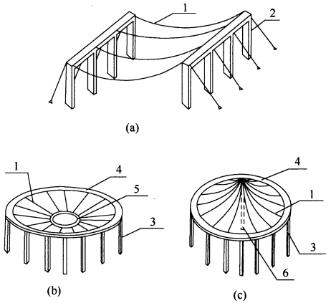
Single cable
1 – Load-bearing cables; 2 – Side columns; 3 – Perimeter columns
4 – Ring beam; 5 – Tension ring; 6 – Center column
2. (Sole net) Sole net is suitable for lightweight roofing. The plane shape can be square, rectangle, polygon, rhombus, circle, oval, and so on.
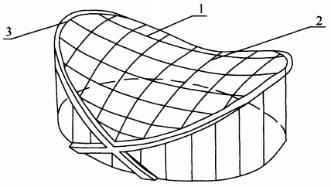
fishing net
1 – load-bearing cables; 2 – stabilizing cables; 3 – arches
3. (Double-layer cable system) A lightweight roof should be used for the double-layer cable system. Load-bearing and stabilizing cables can be combined in different ways, and the two cables should be connected by compression struts or tension cables respectively. When the plane is a rectangle or polygon, the load-bearing cable, and stabilizing cable should be arranged in parallel to form a double-layer cable system in the form of a cable truss; when the plane is round, the load-bearing cable and stabilizing cable should be arranged according to radial shape, and the tensile ring should be set in the center.
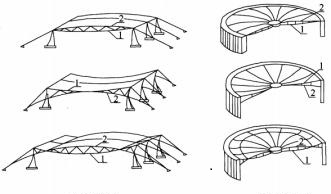
double tethered structure
1 – Load-bearing ropes; 2 – Stabilizing ropes
4. (Transverse stiffening cable system) The Transverse stiffening cable system is suitable for light roofing. When the plane shape is square, rectangle, or polygon, the cables should be arranged parallel along the longitudinal direction. Transverse stiffening members should be trusses or beams.
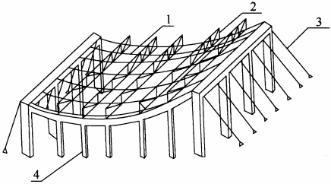
Transverse stiffening cable system
1-cords; 2-transverse stiffening members; 3-anchor cables; 4-columns
5, (diagonal structure) A diagonal structure is appropriate to use a light roof, set the column (mast) should be higher than the roof; the diagonal cable can be arranged in parallel, or according to the radial arrangement.
6. (Tensioned string structures) Lightweight roofing is appropriate for tensioned string structures. Tensioned string structure can be unidirectional, bidirectional, or space arrangement molding to adapt to different shapes of the plane, and should comply with the following provisions:
a. one-way tensile string structure plane shape can be square or rectangle, according to the upper string of different construction methods should be used in tensile string beams, tensile string arch or tensile string arch frame and other forms;
b.The plan shape of a two-way string tensioned structure may be square or rectangular, and it is appropriate to use such as one-way string tensioned structure of various chord construction methods in orthogonal arrangement;
c.The plan shape of the space string tensioning structure may be circular, elliptical, or polygonal, and it is suitable to adopt a radial string tensioning structure or string net shell (string support dome). The grid form of the tensile string net shell (string support dome) should be selected according to the current industry standard “Space Grid Structure Technical Regulations” JGJ7.
7, (cable dome) Cable dome roofing is suitable for the use of membrane materials. When the roof plane is round or oval, the grid of the rope dome should be trapezoidal, joint square, or other suitable forms. The upper chord of the rope dome can be equipped with ridge and valley ropes, the lower chord should be equipped with several layers of ring ropes, and the upper and lower strings should be connected by diagonal ropes and braces.
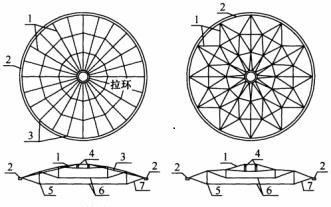
geodesic dome
1-Ridge ropes; 2-Compression rings; 3-Valley ropes; 4-Pull rings;
5-spacers; 6-ring ropes; 7-oblique ropes
8, (cable bearing glass curtain wall) when the cable structure used to support the glass curtain wall, can be used single cable system or double cable system. Single-layer cable systems should adopt single cable, plane cable networks, or curved cable networks. The double-layer cable system is suitable for using a cable truss.
9、(Rope bearing glass light roof) When the rope structure is used to support the glass light roof, it can adopt a single-layered rope system, double-layer rope system, or tension string structure. Single-layer cable system is suitable to adopt curved surface cable network; double-layer cable system is suitable to adopt parallel arrangement or radial arrangement of cable truss; tensioned string structure is suitable to adopt tensioned string arch.











 About Us
About Us 2024-05-06
2024-05-06


